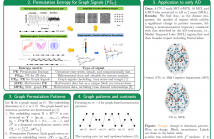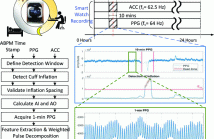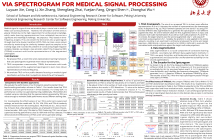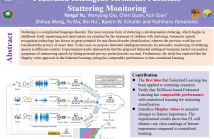
- Read more about EEG-BASED FAST AUDITORY ATTENTION DETECTION IN REAL-LIFE SCENARIOS USING TIME-FREQUENCY ATTENTION MECHANISM
- 1 comment
- Log in to post comments
Auditory attention detection (AAD) based on electroencephalogram (EEG) helps recognize the target speaker in a cocktail party scenario, advancing auditory brain-computer interface development. Previous EEG studies on AAD were largely based on data collected in laboratory settings. In this study, we investigated the AAD with EEG data collected when subjects were walking and sitting in real-life scenarios. To improve the detection accuracy, we proposed the time-frequency attention mechanism to the convolution neural network on EEG data.
icassp海报5.pdf
- Categories:
 67 Views
67 Views
- Read more about Poster for "Graph-based permutation patterns for the analysis of task-related fMRI signals on DTI networks in mild cognitive impairment"
- Log in to post comments
Permutation Entropy (PE) is a powerful nonlinear analysis technique for univariate time series. Recently, Permutation Entropy for Graph signals (PE_G) has been proposed to extend PE to data residing on irregular domains. However, PE_G is limited as it provides a single value to characterise a whole graph signal. Here, we introduce a novel approach to evaluate graph signals at the vertex level: graph-based permutation patterns. Synthetic datasets show the efficacy of our method.
- Categories:
 49 Views
49 Views
- Read more about MAML-Based 24-Hour Personalized Blood Pressure Estimation from Wrist Photoplethysmography Signals in Free-Living Context
- Log in to post comments
Systolic blood pressure (BP) variability at daytime and nighttime, also known as BP dip, has shown its clinical value in diagnosis and treatment of cardiovascular diseases (CVDs). A model agnostic meta learning (MAML)-based 24-hour personalized approach is proposed in this paper for BP estimation using wrist photoplethysmography (PPG) signals from smart watch in free-living context.
- Categories:
 47 Views
47 Views
- Read more about TRLS: A TIME SERIES REPRESENTATION LEARNING FRAMEWORK VIA SPECTROGRAM FOR MEDICAL SIGNAL PROCESSING
- Log in to post comments
Representation learning frameworks in unlabeled time series have been proposed for medical signal processing. Despite the numerous excellent progresses have been made in previous works, we observe the representation extracted for the time series still does not generalize well. In this paper, we present a Time series (medical signal) Representation Learning framework via Spectrogram (TRLS) to get more informative representations. We transform the input time-
- Categories:
 91 Views
91 Views
- Read more about ICASSP 2023 AUDITORY EEG DECODING CHALLENGE
- Log in to post comments
- Categories:
 155 Views
155 Views
- Read more about Spatial Graph Signal Interpolation with an Application for Merging BCI Datasets with Various Dimensionalities
- Log in to post comments
BCI Motor Imagery datasets usually are small and have different electrodes setups. When training a Deep Neural Network, one may want to capitalize on all these datasets to increase the amount of data available and hence obtain good generalization results.
- Categories:
 29 Views
29 Views
- Read more about FEDEEG__FEDERATED_EEG_DECODING_VIA_INTER_SUBJECT_STRUCTURE_MATCHING
- Log in to post comments
With sufficient centralized training data coming from multiple subjects, deep learning methods have achieved powerful EEG decoding performance. However, sending each individuals’ EEG data directly to a centralized server might cause privacy leakage. To overcome this issue, we present an inter-subject structure matching-based federated EEG decoding (FedEEG) framework. First, we introduce a center loss to each client (subject), which can learn multiple virtual class centers by averaging the corresponding class-specific EEG features.
- Categories:
 26 Views
26 Views
- Read more about Federated Intelligent Terminals Facilitate Stuttering Monitoring
- Log in to post comments
Stuttering is a complicated language disorder. The most common form of stuttering is developmental stuttering, which begins in childhood. Early monitoring and intervention are essential for the treatment of children with stuttering. Automatic speech recognition technology has shown its great potential for non-fluent disorder identification, whereas the previous work has not considered the privacy of users' data. To this end, we propose federated intelligent terminals for automatic monitoring of stuttering speech in different contexts.
- Categories:
 88 Views
88 Views
- Read more about Active selection of source patients in transfer learning for epileptic seizure detection using Riemannian Manifold
- Log in to post comments
Epileptic seizure detection from long recordings of scalp electroencephalography (EEG) is a challenging task owing to their unpredictability in nature with the inclusion of noise, artifacts and subject dependency. We hypothesize that selection of training EEG data plays important role in the model performance. Thus, we introduced an active learning based training data selection and modification method with a Riemannian geometry, centroid alignment, tangent space mapping and a support vector machine classifier.
- Categories:
 17 Views
17 Views
- Read more about Improving EEG-based Emotion Recognition by Fusing Time-frequency And Spatial Representations
- Log in to post comments
Using deep learning methods to classify EEG signals can accurately identify people's emotions. However, existing studies have rarely considered the application of the information in another domain's representations to feature selection in the time-frequency domain. We propose a classification network of EEG signals based on the cross-domain feature fusion method, which makes the network more focused on the features most related to brain activities and thinking changes by using the multi-domain attention mechanism.
- Categories:
 21 Views
21 Views